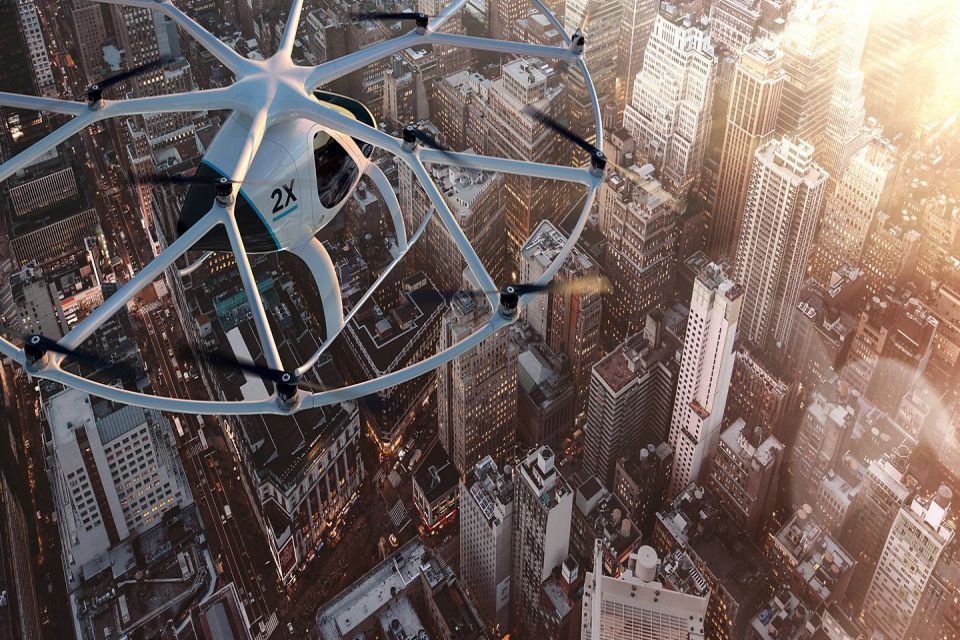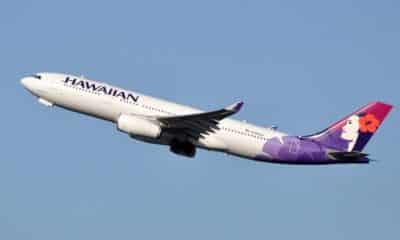Aviation
How Volocopter’s ‘flying taxi’ stations will be running by 2028

How Volocopter’s ‘flying taxi’ stations will use an elaborate system of conveyor belts and lifts to handle 10,000 passengers each day by 2028.
The future of travel has been unveiled by Volocopter – and it seems remarkably efficient. The German flying car start-up has released a video that shows its vision of an urban ‘air taxi’ system that could handle 10,000 passengers each day. The system features elaborate ‘Volo-port’ stations perched on top of skyscrapers that are equipped with conveyor belts, swappable battery packs and lifts to speed up transfer of passengers. This means aircraft are always fully charged and ready to go, according to the company, which claims these futuristic landing pads could be commercially viable for normal people. The company hopes to have a prototype station in place next year but predicts that it will take around ten years before a city-wide system is in place.
The Stuttgart-based start-up’s ambitious plan is to create circular launchpads on the top floor of skyscrapers in cities from where the electric aircraft would take off and land, writes the Verge. They would have a conveyor belt that would transport the vertical takeoff and landing (VTOL) aircraft into an indoor hanger.
From there, they would moved to a garage where maintenance work can be carried out. The system would be so efficient the company claims 1,000 passengers could board and disembark every hour.’It’s about mass transportation of people and how it can be done in a safe way and with what infrastructure,’ Alexander Zosel, Volocopter’s co-founder and chief innovation officer, told the Verge. Mr Zosel said the Volocopter aircraft would need to land every 30 seconds. Having such high volume is important if the company is able to handle lots of passengers and therefore be affordable.
Initially, the taxis would only fly over a short distance with flight times of around 30 minutes and a maximum range of 17 miles (27km). However, some have doubts about how feasible this technology will be – most batteries are still far off offering the power-to-weight ratio required to take off. The company has demonstrated its capabilities in Germany and Dubai where it believed the company is most likely to launch its first service. More recently it announced it partnership with Intel in CES at Las Vegas.
The company stunned attendees during Intel’s keynote by flying the drone right onto the stage, in what a spokesperson admitted was a ‘ballsy’ move. In a presentation about Volocopter’s craft, an exhibitor said it is the ‘world’s first autonomous air taxi.’The craft completed the first unmanned test flight in Dubai this past autumn. ‘Potentially in years to come, you would be able to take your phone out and pull up a transportation application, and similar to what you do with a taxi today, summon this to your location, hop in, tell it where you’re going. ‘And it would autonomously fly you to that location, no pilot required. It’s a safe, reliable form of transportation’, the exhibitor said. The Volocopter craft ‘is essentially a scaled-up super drone,’ he noted. It is fully electric, allowing for zero emission travel. And, it’s quiet enough to be operated in an urban environment.
Volocopter relies on a system of ‘redundancies’ to ensure its safety, meaning there are many propellers, batteries, and motors to compensate in case one goes out. With Intel’s flight control technology and a ‘myriad of sensors,’ the craft is ‘constantly analysing environmental data to ensure those redundancies,’ a Volocopter exhibitor explained.
There are 18 independent motors and propellers, but ‘if that seems like way too many, what it allows for is, you can lose a propeller or several of them and still maintain your flight.’There are nine batteries, ensuring the same type of back-up. According to the firm, rides in the flying taxis would likely be comparable to a trip in an Uber Black.
Courtesy: DailyMail

Aviation
South Korea Introduces Cutting-Edge MRO Center for F-35 and IAI

South Korea is set to make waves in the aerospace industry with the establishment of a cutting-edge Maintenance, Repair, and Overhaul (MRO) hub for F-35 fighter jets and IAI (Israel Aerospace Industries) aircraft.
Central to this initiative is the specialization in converting Boeing 777-ERSF, colloquially known as the “Big Twin,” from passenger to freighter configurations. Under the terms of the agreement, IAI will spearhead the conversion of six B777-300ER and B777-200LR aircraft annually, commencing in 2024. This strategic move is in response to the anticipated surge in demand for wide-body freighter aircraft capable of long-haul flights.
Furthermore, South Korea’s forward-looking vision extends beyond aircraft conversion, with plans to establish a Lockheed Martin F-35 maintenance, repair, and overhaul depot at Cheongju Air Base by 2027. This strategic move not only enhances the operational readiness of South Korea’s air force but also positions the nation as a regional hub for F-35 maintenance expertise.
In preparation for this expansion, thirty Republic of Korea Air Force (ROKAF) engineers and technicians are slated to undergo intensive maintenance training in the United States in 2025, a testament to South Korea’s commitment to fostering local expertise and talent.
IAI’s visionary approach to certification and collaboration underscores the potential for transformative change. With plans for the 777-300ERSF certification process set to unfold in Israel, followed by the rigorous scrutiny of regulatory agencies such as the US Federal Aviation Administration (FAA), the stage is set for the ‘Big Twin’ to soar to new heights of success.
In partnership with esteemed entities like STK and Incheon International Airport Corporation, this collaboration promises to unleash a wave of benefits, amplifying the resilience and competitiveness of the Korean aviation sector while catalyzing job creation and economic prosperity.
Aviation
Lockheed Martin Expresses Interest in Joining AMCA Project

Lockheed Martin, a leading global aerospace and defense company, is demonstrating its dedication to strengthening collaborations with India’s research, industry, and academic sectors. With its rich experience in the aerospace industry and renowned for building some of the world’s most advanced jets, Lockheed Martin is now exploring opportunities to contribute to India’s aerospace sector, potentially providing a significant boost to aerospace technology in the country.
Randy Howard, Vice President of Global Pursuits at Lockheed Martin Aeronautics, recently underscored their interest in exploring “advanced transfer of technology opportunities” with Indian partners, signaling a proactive approach towards fostering technological exchange and advancement in the aerospace domain.
India has been at the forefront of fighter jet development since the 1970s, having produced its own cost-effective fighter jets and combat helicopters, while continually upgrading to maintain competitiveness on a global scale.
Lockheed Martin stands as a dominant force in the aircraft industry, renowned for developing cutting-edge planes like the F35 and F22, some of the most advanced fighter jets globally. They’ve also contributed to projects like the South Korean KF21 aircraft for defense purposes through collaborations.
Now, Lockheed Martin has set its sights on India’s defense sector manufacturing processes, expressing interest in partnering with India on its most anticipated project, the Advanced Medium Combat Aircraft (AMCA), likely to be a 5th generation fighter jet for the Indian military.
Their proposed collaboration could involve a spectrum of advanced technologies, including the Auto Ground Collision Avoidance System (Auto GCAS), a life-saving technology that intervenes to prevent ground collisions, thus significantly enhancing flight safety for Indian pilots.
Lockheed Martin is extending its expertise to design and develop an indigenous cockpit for the F-21 fighter jets, which India is procuring. This collaboration with Tata also includes the development of fighter jet wings. Established in 2023, this partnership adopts a “Ground Floor Design” strategy aimed at equipping India with an in-depth comprehension of 5th-generation cockpit technology and Man-Machine Interface (MMI) systems.
As India’s Fighter jet program advances with finalized aircraft frame and engine prototypes, Lockheed Martin has expressed interest in joining the project. They see a groundbreaking opportunity in cooperative 5th Generation Fighter Development, potentially expediting the AMCA program’s progress through technology and expertise sharing.
Furthermore, Lockheed Martin is keen on collaborating on large-wing, jet-powered UAV platforms, which could enhance India’s unmanned aerial capabilities.
While discussions are ongoing, and specific collaboration details await finalization, this initiative represents a potentially transformative stride in India’s aerospace self-reliance journey and Lockheed Martin’s strategic engagement with the Indian market.
Aviation
Can Airline Seat Cushions Be Used As Life Jackets?

In the event of an aircraft ditching into water, there’s a common question: Can aircraft seats serve as an alternative to life jackets for flotation? The answer lies in understanding their respective functions.
While seat cushions can provide some buoyancy in water, they are not intended nor certified to function as life jackets. Their primary purpose is to offer cushioning for passengers during flight. On the other hand, life jackets are meticulously engineered to keep individuals afloat in water, equipped with buoyancy materials, secure straps, and reflective elements for visibility. They offer numerous advantages over mere cushions.
While a seat cushion might offer temporary assistance in staying afloat, it’s not a dependable substitute for a proper life jacket during an emergency. It’s crucial to utilize approved safety equipment when near bodies of water. A life jacket, designed to keep a person buoyant for extended periods, offers the rigidity needed for prolonged flotation and allows for easy movement of the arms to navigate effectively.
What fabric is used in aircraft seats?
Seats are meticulously designed to fulfill multiple purposes, ensuring passenger comfort, safety, and protection from unforeseen circumstances like fires and accidents. A typical design incorporates an aluminum frame with blocks of polyurethane foam affixed to it. Additionally, a layer of fire-resistant fabric, such as Kevlar or Nomex, is often applied over this framework, topped with a layer of cloth or leather.
Leather seats, while luxurious, are more expensive compared to traditional cloth seats. The majority of fabrics used in seat upholstery contain at least 90% wool fiber, with the remainder typically consisting of polyamide (nylon). Wool stands out as the primary fiber chosen for commercial airline seating fabric due to its desirable properties and suitability for such applications.
What is the lightest economy seat?
In recent times, airlines have been downsizing seat dimensions to accommodate more passengers, resulting in reduced cushion length and leg space. This contrasts with earlier times when airlines offered more generously cushioned seats and ample amenities.
According to Recaro Seats Company, their SL3710 model represents the lightest economy class seat available, weighing in at a mere 8 kg (17.6 lb.), setting a new standard in aircraft seating.
For individuals weighing more than 350 pounds, fitting into a standard economy-class seat can be a challenge due to the narrower dimensions. Economy seats, also referred to as “coach,” “standard,” or “main cabin” seats, typically range from about 40 to 48 centimeters in width, further emphasizing the need for more accommodating seating options.



























